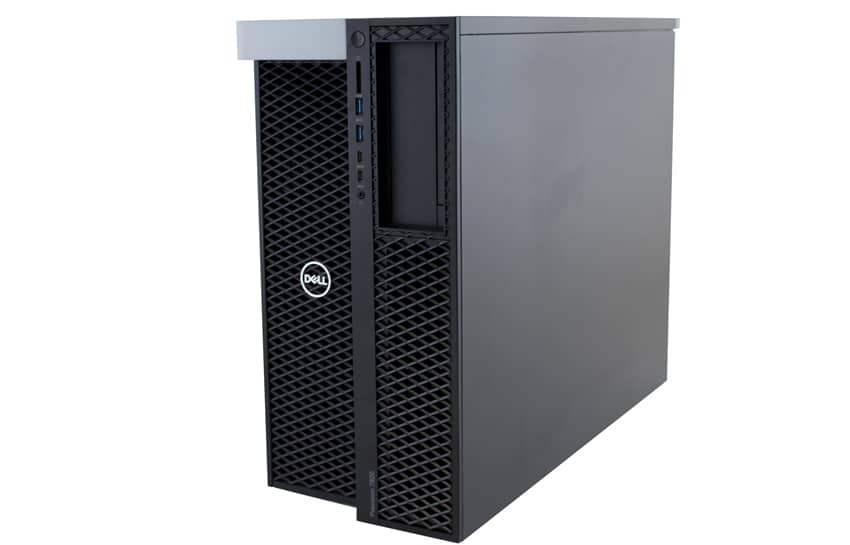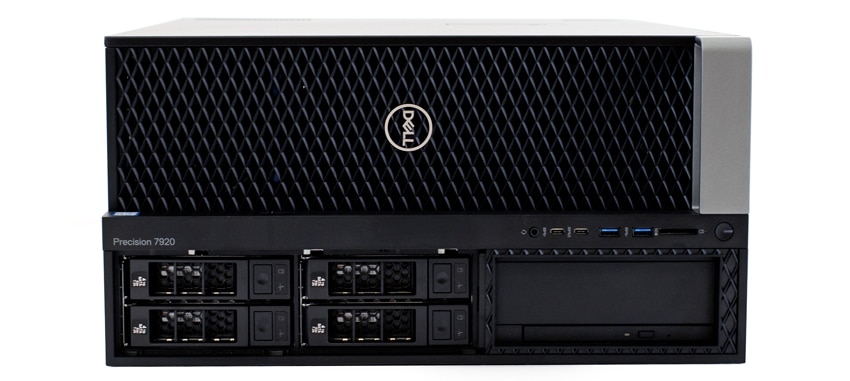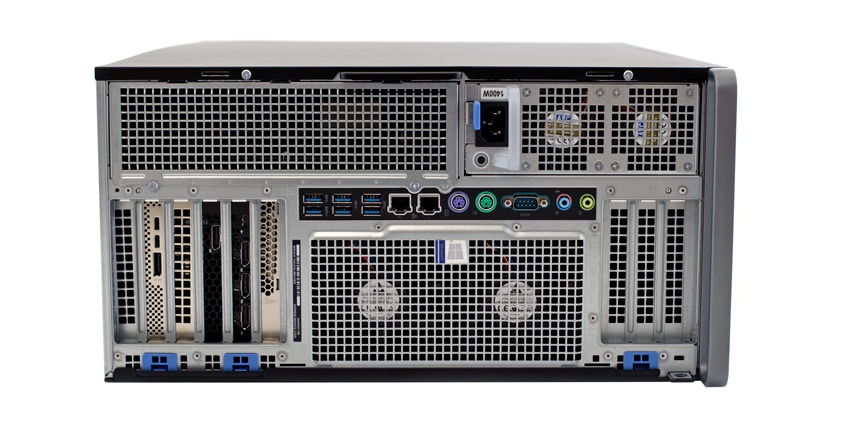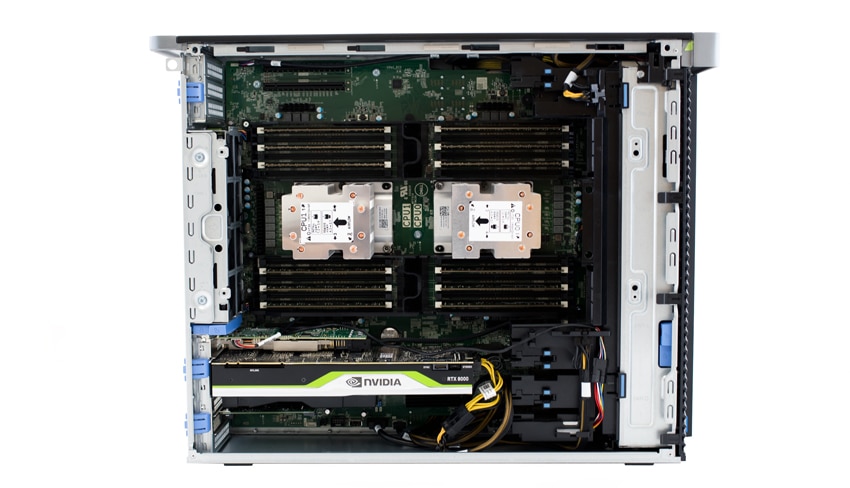The Dell Precision 7920 Tower is a power-driven workstation (dubbed by the company as “the world’s most powerful workstation” no less) designed to handle complex and demanding applications with a huge focus on being able to scale as organizations grow. This is most evident in its extensive customizable options, as configurations range from $2,000 to tens of thousands of dollars. Businesses of all sizes will certainly be able to create a system that best suits their needs.
The Dell Precision 7920 Tower is a power-driven workstation (dubbed by the company as “the world’s most powerful workstation” no less) designed to handle complex and demanding applications with a huge focus on being able to scale as organizations grow. This is most evident in its extensive customizable options, as configurations range from $2,000 to tens of thousands of dollars. Businesses of all sizes will certainly be able to create a system that best suits their needs.
For example, memory options range from 16GB all the way up to 3TB of 2666 MHz RDIMM/LRDIMM RAM, which uses 6-channel memory architecture when using select CPUs. In addition, it comes equipped with the latest Intel Xeon processor Scalable family, which features up to 28 cores per processor or a total of 56 cores when customized with Dual processors. For storage, the 7920 uses a new FlexBay design with up to ten 2.5″ or 3.5″ SATA/SAS drives or up to four M.2 or U.2 PCIe NVMe SSD. The workstation also leverages the hot-swap feature for the M.2 and U.2 PCIe NVMe SSDs, allowing you to actually remove the drives without having to shut down the 7920.

The Dell Precision 7920 Tower also features a huge choice for graphics cards. You can equip the workstation with NVIDIA or AMD cards like the entry-level 2GB Quadro P620 and Radeon Pro WX 2100 cards or the mid-range 8GB NVIDIA Quadro P4000 or Dual Radeon Pro WX 5100 cards. Those with unlimited budgets can go all out with the 32GB Triple NVLink NVIDIA Quadro GV100 option, which adds over $30,000 to the build. There are dozens of other GPU options to choose from.
As far as connectivity goes, the Precision 7920 features an SD card slot, several USB 3.0 ports (one which supports smart power-on), two USB 3.0 Type-C ports (one with PowerShare), a headset port, Line-out port, Serial, PS/2 Mouse and PS/2 Keyboard ports, and two RJ45 network ports (managed optionally).
Our particular build for this review includes: Dual Intel Xeon Platinum 8260 2.4GHz processors, Nvidia Quadro RTX 8000 graphics, 96GB DDR4 2933MHz RDIMM ECC memory, 16TB 7200rpm SATA HDD, Dell Ultra-Speed Drive Duo PCIe SSD x8 Card, 512GB M.2 PCIe NVMe Class 50 Solid State Drive, MegaRAID SAS 9460-16i 12Gb/s PCIe SATA/SAS HW RAID controller (4GB cache), and Thunderbolt 3 PCIe card with 2 Type C Ports, 1 DP in. Cost for this build is $23,288.79.
Dell Precision 7920 Tower Specifications
| Processor Options | One or two Intel Xeon Scalable Processor family CPUs (1st and 2nd generation) with up to 28 cores per processor and Intel Advanced Vector Extensions, Intel Trusted Execution Technology, Intel AES New instructions, Optimized Intel Turbo Boost and optional Intel vPro™ technology |
| Operating System Options | Windows 10 Pro for Workstations (up to 4 Cores)
Windows 10 Pro for Workstations (4 Cores Plus) Red Hat® Enterprise Linux® 7.5 Red Hat Enterprise Linux 8.0 (Sept. 2019) is required for 2nd Generation Xeon SP (Cascade Lake) CPUs Ubuntu Linux 16.4 Ubuntu Linux 18.04 NeoKylin 6.0 SP3 |
| Chipset | Intel C621 (Lewisburg) |
| Memory Options | Six channel memory up to 1.5TB 2666MHz DDR4 ECC memory with dual CPUs, up to 3TB with select CPU SKUs
Up to 768GB of 2933MHz DDR4 ECC memory 24 DIMM Slots (12 DIMMs per CPU). Note: memory speed is dependent on specific Intel Xeon Scalable Processor CPU installed |
| Storage Options | Storage Options2 Front accessible FlexBays support up to 4 x 2.5”/3.5” SATA HDD/SSDs and up to 8 drives with rear FlexBays populated with integrated Intel SATA controller.
Up to 10 x 2.5”/3.5” SATA/SAS drives can be supported with the rear FlexBays and 5.25” bay (2 x 2.5”/3.5”) populated and using the optional Broadcom MegaRAID 9460-16i controller. Up to 4 front accessible (hot plug) M.2/U.2 NVMe PCIe SSDs in FlexBays on enabled PCIe backplane chassis with integrated Intel controller (>2 drives requires dual CPUs). Up to 4 M.2/U.2 drives (1 CPU) with MegaRAID 9460 NVMe hardware RAID controller option – see controller section. Note Precision PCIe FlexBay backplane and single M.2 Module (incl. 1 M.2 PCIe NVMe carrier) kits are available for customers to convert standard FlexBays to support Intel and new MegaRAID NVMe controller options (different kits). Intel NVMe RAID 0, 1 options on 1st 2 drives only (Intel RSTe vROC). NVMe HW RAID 0,1,5,10 with MegaRAID 9460 NVME controller on up to 4 drives – single or dual CPUs.) Up to 8 x M.2 NVMe PCIe SSDs via 2 x Dell Ultra-Speed Drive Quad x16 cards (maximum requires dual CPUs), NVMe RAID 0,1,10 option on 1st card (Intel RSTe vROC). RAID 0,10 can span 2 Ultra-Speed Drive Quad x16 cards (APOS) but they cannot contain the Operating System boot drive. M.2 NVMe PCIe SSDs Up to 8 x 2TB drives on 2 Dell Precision UltraSpeed Drive Quad x16 cards. Requires dual CPUs. Front FlexBay M.2/U.2 NVMe PCIe SSDs
3.5” SATA 7200 RPM Hard Drives
3.5” SAS 7200 RPM 12Gb/s
2.5” SAS 10K RPM 12Gb/s
2.5” SAS 15K RPM 12Gb/s
M.2 PCIe SED SSD
|
| Graphics Options | Support for 4 PCI Express® x16 Gen 3 graphics cards – change to up to 900W with maximum of
3 x 300W double width graphics cards in 3 slots (dual CPU configuration) and up to 2 x 375W cards (when available). 220VAC input supply recommended for 900W configurations. High end 3D cards:
Mid-range 3D cards:
Entry 3D cards:
Professional 2D cards: NVIDIA NVS 310 |
| Controller | Integrated: Intel® chipset SATA controller (6Gb/s) with 8 SATA ports plus dedicated port for an optical drive. Intel RSTe software RAID 0,1,5,10.
Intel RSTe (vROC) software RAID 0,1,10 option (motherboard activation key) for M.2 NVMe PCIe SSDs on 1st Dell Ultra-Speed Drive Quad x16 card or Duo x8 card (RAID 0,1) and for 2 x front FlexBay M.2/U.2 NVMe PCIe SSDs (RAID 0,1) or front FlexBay NVMe PCIe SSDs RAID 0,10 can span 2 Ultra-Speed Drive Quad x16 cards (APOS) but they cannot contain the Operating System boot drive Customer kit available for Intel RSTe (vROC) motherboard activation key for NVMe RAID support. Optional: Broadcom MegaRAID® SAS 9440-8i 12Gb/s SAS (6Gb/s SATA) PCIe controller, 8 ports, Software RAID 0,1,5,10. MegaRAID® SAS 9460-16i 12Gb/s SAS (6Gb/s SATA) ) PCIe controller (4GB cache with Flash module/Super Cap backup) Hardware RAID 0,1,5,10 MegaRAID 9460 controller NVMe option supports up to 4 front FlexBay M.2/U.2 NVMe PCIe SSDs with Hardware RAID 0,1,5,10 |
| Communications | Integrated: Intel® i219 & i210 Gigabit Ethernet controllers with Intel Remote Wake UP, PXE and
Jumbo frames support Optional: Intel® i210 10/100/1000 single port PCIe (Gen 3 x1) gigabit network card, Intel® X550-T2 10GbE dual port PCIe (Gen 3 x4) network card, Intel Dual Band Wireless AC 8265 (802.11ac) 2×2 + |
| Audio Controller | Bluetooth module, Aquantia AQN-108 2.5Gbit/5Gbe single port PCIe (Gen3 x4) network card |
| Speakers | Integrated Realtek ALC3234 High Definition Audio Codec (2 Channel) |
| Add-in cards | Optional: Dell Precision Ultra-Speed Drive Duo (HH/HL,x8) & Ultra-Speed drive Quad (FH/FL,x16) with active cooling. Support for up to 2 and 4 M.2 PCIe NVMe SSDs respectively.
Optional USB 3.1 (Gen 2) 10Gb/s Type C card (2 ports) 1 DP pass-through port Optional dual & quad display Teradici PCoIP remote workstation host PCIe cards |
| I/O Ports | Optional Thunderbolt 3 PCIe Card (2 ports) 1 DP pass-through port
Optional Serial Port PCIe Card Front
Internal
Rear
|
| Chassis | HxWxD: 17.05” x 8.58” x 22.29”, 433mm x 218mm x 566mm. Starting at Weight 45.0lb/20.4kg Optional 19” rackmount rail kit Bays: (4) FlexBays and (1) 5.25” FlexBay supporting up to 10 x 3.5” or 2.5” drives (with MegaRAID 9460i-16 controller) (1) Slimline optical bay option adjacent to 5.25” bay; Available APOS, 2nd 5.25” bay kit – consumes/ converts 2 FlexBays, (1) SD slot UHS ll Class 3 with read only support (SW enabled). Available PCIe backplane FlexBay chassis supporting 1-2 x or 3-4 x (dual CPUs) M.2/U.2 PCIe NVMe SSDs. Up to 4 M.2/U.2 drives with MegaRAID 9460 NVMe hardware RAID controller option. Slots: All slots PCIe Gen 3: (2) PCIe x16, (2) additional x16 slots with 2nd CPU; (1) PCIe x8 open ended, (1) x16 wired as x 4, (1) x16 wired as x1 Power Supply: 1400W (input voltage 181VAC – 240VAC) –90% efficient (80PLUS Gold Certified) Externally accessible/removable/lockable |
| Security Options (Check regional availability) | Trusted Platform Module (TPM 2.0); Optional CAC/ PIV card reader for slimline bay, chassis Intrusion switch; Setup/BIOS Password; I/O Interface Security; Kensington lock slot, Padlock ring, lockable power supply; Optional hard drive locking sleds (key lock), Dell Data Guardian, Dell Endpoint Security Suite Enterprise Lockable front bezel (covers front FlexBays), Front FlexBay NVMe drives are removable (hot swap) |
| Manageability | AMT or vPro with DASH support Dell vPro Enhancements (Grasslake) SNMT/CIM vis OMCI Dell Command Suite |
| Regulatory and Environmental Compliance | Energy Star® configurations available including 80 PLUS® registered Gold power supplies; EPEAT® registered (see epeat.net for specific registration rating/status by country); China CECP; GS Mark. For a complete listing of declarations & certifications, see Dell’s regulatory & compliance homepage at dell.com/regulatory_compliance |
| Warranty & Support Services | 3-Year Limited Hardware Warranty and 3-year NBD On-Site Service after Remote Diagnosis Optional: Dell ProSupport is designed to rapidly respond to your business’s needs, help protect your investment and sensitive data, and provide enhanced proactive support services to help reduce risk and complexity within your IT environment |
Design and Build
With a starting weight of 45 pounds, this tower is a monstrous machine that measures 17.13″ high x 8.5″ wide x 21.46″ deep. The Precision 7920 packs a ton of power inside this beefy chassis that is arguably suitable for self defense. Much hasn’t changed from his predecessor as its design goes: it features a both HDD and a front bezel (which can easily be removed) and connectivity is stacked vertically in the center. The 7920 is also comes with a same handle protruding at the top left, making it easy to transport or move around in the office.
For connectivity and functionality, the front panel features a Power button/light, a drive activity light, an SD card slot, 2x USB 3.0 ports, two USB 3.0 Type-C ports (one with PowerShare), a headset port, and an optical drive tray. The panel can be easily removed to access the drives while the PCIe sled allows for easy access/replacement of the M.2 drive.
Turning the 7920 around reveals the bulk of the connectivity, which includes microphone/line-in and line-out port, a serial port, PS/2 mouse and keyboard ports, RJ45 network port, 6x USB 3.0 gen 1 Type A ports, discrete graphics card slot, and expansion card slots. The whole rear panel also acts as ventilation.
Our review unit is equipped the uber-powerful NVIDIA Quadro RTX 8000 high-end professional graphics card. Priced at roughly $5,500, the RTX 8000 has whopping 48GB of high-speed GDDR6 memory and supports NVIDIA NVLink. It also features 4,608 CUDA and 576 NVIDIA tensor cores, making this a powerful GPU for artists and designers that is VR capable.
NVIDIA Quadro RTX 8000 Specifications:
| CUDA Parallel-Processing Cores | 4,608 |
| NVIDIA Tensor Cores | 576 |
| NVIDIA RT Cores | 72 |
| GPU Memory | 48 GB GDDR6 with ECC |
| RTX-OPS | 84T |
| Rays Cast | 11 Giga Rays/Sec |
| FP32 Performance | 16.3 TFLOPS |
| Max Power Consumption | Total Board Power: 295W Total Graphics Power: 260W |
| Graphics Bus | PCI Express 3.0 x 16 |
| Display Connectors | DP 1.4 (4), VirtualLink (1) |
| Form Factor | 4.4” (H) x 10.5” (L) Dual Slot |
Performance
To see what the Dell Precision 7920 Tower is capable of, we put it through three resource-intensive tests (they also allow us to measure the capabilities of the Quadro NVIDIA Quadro RTX 8000). In addition, we will be comparing Dell’s new tower workstation to the Dell Precision 7740, which will demonstrate the leap in performance between a tower and a mobile workstation. For example, our review model is equipped with the NVIDIA Quadro RTX 8000 vs. the 7740’s NVIDIA Quadro RTX 5000, 32GB DDR4 memory, and a 9th Gen Intel Core i9-9980HK CPU.
- Key Specification Differences:
- 7920 Tower
- 7740 Mobile Workstation
- CPU
- Dual Intel Xeon Platinum 8260
- Clockspeed: 2.40 GHz (3.90 GHz max turbo)
- Cores: 24 per CPU (48 total)
- Intel Core i9-9980HK
- Clockspeed: 2.40 GHz (5.00 GHz max turbo)
- Cores: 8
- Dual Intel Xeon Platinum 8260
- GPU
- NVIDIA Quadro RTX 8000 (48 GB GDDR6)
- NVIDIA Quadro RTX 5000 (16 GB GDDR6)
- RAM
- 96GB DDR4
- 32GB DDR4
This first test is the SPECviewperf 13 benchmark, which is the worldwide standard for measuring graphics performance based on professional applications. SPECviewperf runs 9 benchmarks called “viewsets,” which represent graphics content and behavior from actual applications and include categories such as 3D Max, CATIA, Creo, Energy, Maya, Medical, Showcase, Siemens NX, and Solidworks.
| SPECviewperf 13 | ||
|---|---|---|
| Viewsets | Dell Precision 7920 Tower – Dual Intel Xeon Platinum 8260 (NVIDIA Quadro RTX 8000) |
Dell Precision 7740 Mobile Workstation – Intel Core i9-9980HK (NVIDIA Quadro RTX 5000) |
| 3dsmax-06 | 261.27 | 172.35 |
| Catia-05 | 312.07 | 223.33 |
| Creo-02 | 266.88 | 198.34 |
| Energy-02 | 74.67 | 46.77 |
| Maya-05 | 335.9 | 203.06 |
| Medical-02 | 113.71 | 85.25 |
| Showcase-02 | 184.19 | 110.51 |
| Snx-03 | 501.21 | 261.37 |
| Sw-04 | 167.19 | 127.65 |
Unsurprisingly, the Dell Precision 7920 showed huge numbers. While it did well in all categories a few places where it truly shined include Snx-03 (501.21), Maya-05 (335.9), Catia-05 (312.07), and 3dsmax-06 (261.27).
We also ran SPECworkstation3, a test that specializes benchmark designed for testing all key aspects of workstation performance; it uses over 30 workloads to test CPU, graphics, I/O, and memory bandwidth. The workloads fall into broader categories such as Media and Entertainment, Financial Services, Product Development, Energy, Life Sciences, and General Operations. We are going to list the broad-category results for each, as opposed to the individual workloads. The results are an average of all the individual workloads in each category.
| SPECworkstation3 | ||
|---|---|---|
| Category | Dell Precision 7920 Tower – Dual Intel Xeon Platinum 8260 (NVIDIA Quadro RTX 8000) |
Dell Precision 7740 Mobile Workstation – Intel Core i9-9980HK (NVIDIA Quadro RTX 5000) |
| M&E | 4.18 | 2.30 |
| ProdDev | 5 | 2.43 |
| LifeSci | 4.78 | 1.82 |
| Energy | 4.25 | 1.59 |
| FSI | 9.19 | 1.75 |
| GeneralOps | 1.84 | 1.95 |
| GPU Compute | 5.05 | 3.91 |
Here the 7920 handily outperformed the 7740. This test wasn’t a clean sweep for the 7920 though, as the 7740 edged it out by a tenth of a point in GeneralOps.
Conclusion
The Dell Precision 7920 showed us some very impressive results for a desktop workstation. It is hugely customizable with configurations ranging in price from $2,000 to tens of thousands of dollars, which will certainly allow organizations to build a system that best suits their needs and budget. Options include many different professional graphics card options ranging from entry level cards like the Radeon Pro WX 2100 and NVIDIA Quadro P1000 to expensive, high-end ones like the Radeon Pro WX 9100 and the NVIDIA Quadro RTX 8000. For memory, options range from 16GB all the way up to a whopping 3TB of RAM, while processors include the latest Intel Xeon Scalable family with up to 28 cores per processor or a total of 56 cores when customized with Dual processors. Storage options are plentiful as well. Needless to say, this is a highly scalable workstation.
The configuration of our Dell Precision 7920 was a bit unique in regards to its processors, being dual Intel Platinum 8260 CPUs. These are nearly top of class server-grade CPUs, with 24 cores each (48 cores combined). In a server or a highly multi-threaded application setting, these perform very well, but for some more traditional workloads they can actually start to force some corner cases. This was the case with some of our benchmarks, that were never designed for such high core count CPUs. With that in mind, to gauge its performance, we put the 7920 through two distinct graphics-intensive workstation benchmarks (the SPECviewperf and SPECworkstation) and compared it to the Dell Precision 7740 mobile workstation, which we reviewed last year. Looking at the graphics-intensive SPECviewperf test, the 7920 unsurprisingly demonstrated outstanding performance in all categories and shined in Snx-03 (501.21), Maya-05 (335.9), Catia-05 (312.07), and 3dsmax-06 (261.27). In our SPECwpc benchmark (which gauges CPU, graphics, I/O, and memory bandwidth performance) the 7920 didn’t fair as well comparatively, but was more related to the way multi-threading is handled with the benchmark. While it demonstrated its ability to perform under intensive workloads it didn’t quite hit the high numbers one might expect, but this was more a trade off of the CPUs selected, not the platform.
Overall, the 7920 is a highly customizable workstation offering some of the best hardware options on the market. It performed well in our workstation-class SPECviewperf and SPECworkstation benchmarks, although with a slightly more toned-down processor it would most likely yield even higher results.



